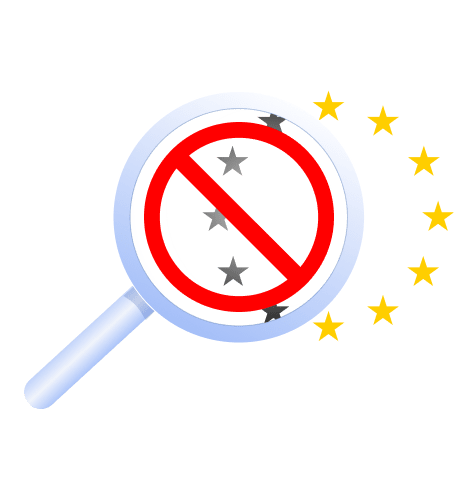What Are Dark Patterns?
Dark patterns are design tactics intentionally crafted to manipulate user behavior, leading them to make unintended decisions that benefit the website operator but may harm the user’s autonomy or privacy. These designs can be subtle or overt, but their goal is the same: nudging, misleading, or pressuring users into actions they may not fully understand or intend, often at the expense of personal data privacy and undermining data protection principles and user consent.
Examples of dark patterns are widespread and can include hidden costs, confusing or deceptive language, pre-checked consent boxes, and manipulative pop-ups. They commonly appear in cookie consent banners, social media platforms, and online retail spaces. When users encounter such patterns, they can feel tricked, resulting in a negative user experience and decreased trust in digital services.
Categories of Dark Patterns
Dark patterns can be categorized into several types, each with its own unique characteristics and manipulative tactics. Understanding these categories is essential to recognizing and avoiding dark patterns in digital design. By identifying these patterns, users and designers alike can work towards creating more ethical and transparent online interactions.
Default Settings and Ease of Use
Default settings and ease of use are two common categories of dark patterns that can significantly impact user autonomy. Default settings refer to the pre-selected options or settings that are presented to users as the default choice. These settings can be designed to manipulate users into making certain choices or providing personal data without their explicit consent. For example, a website may have a default setting that allows it to collect user data, such as location information or browsing history, without the user’s knowledge or consent.
Ease of use, on the other hand, refers to the design of user interfaces that make it easy for users to make certain choices or take certain actions. While ease of use can be a positive design principle, it can also be used to manipulate users into making choices that they may not intend to make. For instance, a website may use a simple and intuitive interface to encourage users to sign up for a service or provide personal data without fully disclosing the terms and conditions of the service. This subtle manipulation can lead to unintended data sharing and a breach of user trust.
Reward and Punishment Tactics
Reward and punishment tactics are another category of dark patterns that can influence user behavior. These tactics involve using rewards or punishments to encourage users to make certain choices. Rewards can take many forms, such as discounts, free trials, or exclusive content, enticing users to provide personal data or sign up for services. For example, a website may offer a discount to users who sign up for a service or provide personal data, but only if they do so within a certain timeframe. This creates a sense of urgency and can pressure users into making a decision without fully considering the consequences.
Punishments, on the other hand, can include penalties, fines, or negative consequences for not making a certain choice. A website might use negative language or imagery to discourage users from canceling a subscription or opting out of data collection. These tactics can create a coercive environment where users feel compelled to comply, even if it goes against their best interests.
It’s worth noting that these categories are not mutually exclusive, and dark patterns can often involve a combination of different tactics and techniques. By understanding these categories and how they are used, designers and developers can create more ethical and user-centered designs that prioritize transparency, informed consent, and user autonomy.
The Problem with Dark Patterns
Dark patterns undermine user autonomy by manipulating users into choices that may not align with their best interests. These manipulations compromise privacy and data protection by pressuring users into sharing sensitive information. For example, a social media platform might use dark patterns to persuade users to enable data-sharing features they otherwise would not. These manipulations erode the transparency that is fundamental to ethical online interactions.
Furthermore, dark patterns often create a lack of accountability for data processors, as users may not realize how much data is being collected or how it will be used. This lack of clarity not only violates user trust but also contradicts the principles of transparency and consent that are critical in data protection regulations such as the GDPR.
Data Protection Laws and Regulations
The General Data Protection Regulation (GDPR) establishes clear requirements for data protection, including transparency, informed consent, and respect for user autonomy. The European Data Protection Board (EDPB) has outlined guidelines emphasizing that data processing must prioritize user rights and control over personal data.
GDPR prohibits dark patterns that trick users into providing consent. Instead, it mandates that consent must be freely given, informed, and specific. Companies failing to adhere to GDPR’s standards, including the use of dark patterns, can face significant fines and reputational damage, making regulatory compliance essential for online platforms.
Impact of Dark Patterns on User Experience
Dark patterns create a frustrating user experience by confusing users or coercing them into actions they might otherwise avoid. Users who encounter dark patterns feel a sense of manipulation, which can lead to mistrust and disinterest in interacting with a brand.
Moreover, dark patterns create opaque user interfaces that impair transparency. Users are less likely to understand the terms they agree on, leading to further confusion and potential regret over their choices. Over time, this type of design results in diminished user engagement and a damaged reputation for companies employing such tactics.
Designing Compliant Online Interactions
Compliant design prioritizes clarity and transparency in all user interactions. Online interfaces that respect user autonomy provide straightforward options without the use of deceptive language or coercive tactics. This requires a shift in design philosophy: instead of prioritizing data collection at all costs, companies must focus on user empowerment and informed consent.
Ensuring compliance means crafting interfaces that are easy to understand and navigate. This includes clear opt-in options for data collection and processing, easy-to-locate privacy settings, and accessible ways to opt-out. By adhering to these principles, companies foster a trustworthy environment that respects user rights.

Ethical Design Patterns for Cookie Consent
Ethical cookie consent practices involve transparent disclosures about data collection. This means no hidden language or pre-checked boxes, which are forms of dark patterns that subtly coerce users into agreeing. Instead, cookie consent banners should present users with clear options to accept or reject different categories of cookies, from necessary to marketing ones.
Moreover, users should have control over whether their data is used for tracking and advertising. Allowing users to easily withdraw consent or modify their preferences is essential for GDPR compliance and for building a reputation as a privacy-conscious company.
The Importance of Transparency in Online Interactions
Transparency is a cornerstone of data protection, as users have the right to know how their data is being collected, processed, and shared. When companies disclose this information openly, users feel more secure and are more likely to provide genuine consent.
GDPR emphasizes transparency as a key principle, requiring that organizations inform users about data processing activities. Transparent interactions not only comply with regulations but also enhance trust and loyalty among users, who appreciate clear and honest communication regarding their personal data.
Regulatory Compliance and Dark Patterns
Compliance with data protection regulations, including GDPR and the California Consumer Privacy Act (CCPA), requires companies to avoid dark patterns. Regulatory authorities are increasingly scrutinizing companies for using deceptive tactics that can impair user autonomy, particularly in the case of large platforms with substantial influence over users’ personal data.
Companies using dark patterns may face fines, legal repercussions, and public backlash, highlighting the importance of adopting compliant, ethical design patterns. Avoiding dark patterns ensures companies stay within legal boundaries and maintain a positive public image.
The Business Case for Compliant Design Patterns
Ethical, compliant design benefits businesses by establishing trust with users, which leads to higher engagement and loyalty. When users feel empowered and understand how their data is used, they are more likely to engage positively with the brand.
Companies that prioritize GDPR-compliant design also reduce their risk of legal action, which can be costly and damaging to their reputation. Thus, compliant design patterns are a win-win for businesses, combining regulatory adherence with long-term customer relationships.

Best Practices for Implementing GDPR Compliance
To implement GDPR compliance, companies should adopt design practices that prioritize transparency, data minimization, and respect for user autonomy. This involves avoiding pre-checked consent boxes, using clear language in consent forms, and offering users an easy way to change their preferences.
Additionally, companies should invest in robust data protection controls to demonstrate their commitment to compliance and to avoid potential fines or sanctions. These practices not only meet regulatory requirements but also foster a transparent, user-friendly experience.
Cognitive Biases and Dark Patterns
Dark patterns often exploit cognitive biases to influence user behavior. For example, scarcity tactics, such as limited-time offers, exploit the fear of missing out, while default options leverage status quo bias to push users into consent without questioning.
Understanding these biases can help companies avoid unethical practices and instead design interfaces that respect user autonomy and align with GDPR principles. Educating users about these biases can also empower them to make informed choices about their data.
Role of Privacy Authorities
Privacy authorities like the EDPB play a crucial role in guiding companies on how to implement GDPR-compliant practices. They issue guidelines on how to avoid manipulative design patterns and offer clarity on data processing principles.
These authorities also conduct audits and impose penalties on companies that violate data protection laws. This regulatory oversight is essential for protecting user rights and ensuring that companies prioritize data protection in their business practices.
Cookie Consent Banners: An Ethical Approach
Cookie consent banners are often the first interaction users have with data privacy on a website. An ethical banner should provide users with clear options and avoid techniques like pre-checked boxes or confusing language.
GDPR-compliant cookie banners ensure that users’ consent is freely given and informed. By designing these banners with clarity and transparency, companies can foster trust and improve user experience from the start.
Confusing Language in User Interfaces
Confusing language in user interfaces is a common dark pattern, often making it difficult for users to understand what they consent to. This may include ambiguous terms, technical jargon, or unclear descriptions of data processing activities.
For GDPR compliance, companies must use plain language to help users understand their choices. This practice respects user autonomy and is essential for achieving valid consent under data protection laws.

Avoiding Deceptive Design Patterns on Social Media
Social media platforms often rely on dark patterns to encourage data sharing, tracking, and engagement. For instance, social media interfaces may use nudging techniques to push users toward enabling more data-sharing options.
To comply with GDPR, social media platforms must prioritize transparency and user autonomy. Avoiding deceptive designs fosters trust and helps companies avoid regulatory scrutiny for non-compliant practices.
How the Online Advertising Market Uses Dark Patterns
The online advertising market often uses dark patterns to increase user data collection. Common tactics include misleading opt-ins and difficult-to-access opt-out options, which can lead to excessive data sharing without users’ informed consent.
GDPR and CCPA regulations require advertisers to obtain valid, freely given consent before processing personal data. To avoid regulatory risks, companies must develop advertising strategies that respect user privacy and adhere to data protection laws.
Empowering Users to Withdraw Consent
GDPR mandates that users should be able to withdraw consent as easily as they give it. However, dark patterns can make this process difficult, with hidden settings or confusing interfaces that discourage users from opting out.
Empowering users to withdraw consent demonstrates respect for their rights and strengthens a company’s compliance with data protection laws. An easy-to-navigate interface for managing consent settings is a key feature of GDPR-compliant design.
Consumer Protection and Deceptive Practices
Consumer protection laws, including GDPR, protect users from deceptive practices that impair their autonomy. Companies that use dark patterns to lead users to make unwanted decisions can face serious consequences under these regulations.
To protect consumers, companies must commit to transparency, clearly inform users about data practices, and avoid manipulative techniques. This alignment with GDPR principles builds trust and ensures compliance with data protection regulations.
Conclusion
GDPR compliance requires a focus on transparency, user autonomy, and ethical design principles. Avoiding dark patterns is essential for companies to maintain user trust, meet legal obligations, and create positive user experiences. By adhering to GDPR standards and implementing transparent, user-friendly interfaces, businesses can build strong, lasting relationships with their users while safeguarding privacy rights.




